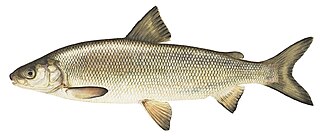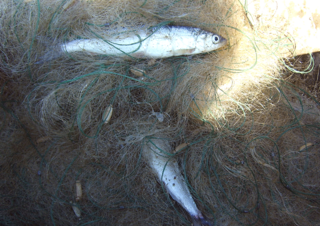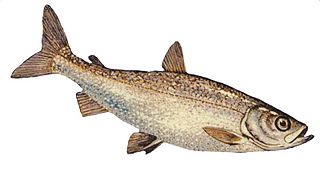
Coregonus is a diverse genus of fish in the salmon family (Salmonidae). The Coregonus species are known as whitefishes. The genus contains at least 68 described extant taxa, but the true number of species is a matter of debate. The type species of the genus is Coregonus lavaretus.

Lake Huron is one of the five Great Lakes of North America. Hydrologically, it comprises the easterly portion of Lake Michigan–Huron, having the same surface elevation as Lake Michigan, to which it is connected by the 5-mile-wide (8.0 km), 20-fathom-deep Straits of Mackinac. It is shared on the north and east by the Canadian province of Ontario and on the south and west by the U.S. state of Michigan. The name of the lake is derived from early French explorers who named it for the Huron people inhabiting the region.

The ciscoes are salmonid fish that differ from other members of the genus in having upper and lower jaws of approximately equal length and high gill raker counts. These species have been the focus of much study recently, as researchers have sought to determine the relationships among species that appear to have evolved very recently. The term cisco is also specifically used of the North American species Coregonus artedi, also known as lake herring.

The shortnose cisco is a North American freshwater whitefish in the salmon family Salmonidae. One of the members of the broader Coregonus artedi species complex of ciscoes, it is native to the Great Lakes of Canada and the United States. Its population has been declining and it has disappeared from some of its earlier haunts. The last reported population was restricted to Georgian Bay off Lake Huron in Canada. It is thought that declines in the population of this fish may be linked with the arrival of the sea lamprey, in the Great Lakes. The International Union for Conservation of Nature has rated the conservation status of this fish as "critically endangered", and possibly extinct.
The longjaw cisco was a deep-water cisco or chub, usually caught at depths of 100 metres (328 ft) or more from Lakes Huron, Michigan, and Erie. Its Latin name was derived from Alpena, a city in Michigan. Silver colored and growing to a maximum length of about 30 centimeters long, the extinction of longjaw cisco was a result of overfishing, pollution of the Great Lakes and the disruption of Great Lakes food chains after the introduction of the sea lamprey.

The deepwater cisco was one of the largest ciscoes in the Great Lakes. Its average length was 30 cm and it was about 1.0 kilogram in weight. Occurring only in Lakes Huron and Michigan, and inhabiting waters between 50 and 150 metres deep, it was difficult to distinguish from other ciscoes and was possibly the same species as the shortjaw cisco. The deepwater cisco was distinguished by usually having fewer than 33 gill rakers, relatively long pectoral fins, and unpigmented jaws. It was a silvery colour with a pink or purple lustre and a green or blue back. It spawned in August and September, earlier than most other ciscoes. Not much is known about its specific behaviors. Its diet consisted of Mysis relicta, fingernail clams, and various aquatic insects. Because of its large size, the deepwater cisco was heavily fished commercially.

The blackfin cisco was a North American salmonid fish in the freshwater whitefish sub-family Coregoninae. This silvery, deep-bodied fish with black fins, large eyes, a blunt snout and a terminal mouth, was one of the largest forms of ciscoes. The blackfin cisco used to inhabit the Great Lakes of North America until recently, but has been reported to have gone extinct. The blackfin cisco is a member of the C. artedi complex, whose taxonomy has not yet been resolved, and it may not represent a valid species.

The omul, Coregonus migratorius, also known as Baikal omul, is a whitefish species of the salmon family endemic to Lake Baikal in Siberia, Russia. It is considered a delicacy and is the object of one of the largest commercial fisheries on Lake Baikal. In 2004, it was listed in Russia as an endangered species.

The deepwater sculpin is a species of freshwater fish in the family Cottidae of order Scorpaeniformes. It is a glacial relict, native to a limited number of deep, cold lakes in Canada and the United States.

Coregonus hoyi, also known as the bloater, is a species or form of freshwater whitefish in the family Salmonidae. It is a silvery-coloured herring-like fish, 25.5 centimetres (10.0 in) long. It is found in most of the Great Lakes and in Lake Nipigon, and inhabits underwater slopes. This fish is not to be confused with the extinct deepwater cisco, a large fish that shared a common name with the bloater.

The shortjaw cisco is a North-American freshwater whitefish in the salmon family. Adult fish range to about 30 cm (12 in) in length and are silver, tinged with green above and paler below. One of the members of the broader Coregonus artedi complex of ciscoes, it is distributed widely in the deeper lakes of Canada, but populations in the Great Lakes have been declining and it is no longer present in Lakes Michigan, Huron, and Erie. It feeds mainly on crustaceans and insect larvae and spawns in the autumn on the lake bed. It is part of the important cisco (chub) fishery in the Great Lakes. The International Union for Conservation of Nature has rated its conservation status as "vulnerable". Shortjaw cisco have however evolved from the cisco Coregonus artedi independently in different lakes and different parts of the range, and conservation assessments therefore should be made on a lake-wise rather than range-wide basis.

Coregonus artedi, commonly known as the cisco, is a North American species of freshwater whitefish in the family Salmonidae. The number of species and definition of species limits in North American ciscoes is a matter of debate. Accordingly, Coregonus artedi may refer either in a narrow sense to one of the several types of cisco found e.g. in the Great Lakes, or in a broad sense to the complex of all ciscoes in continental North American lakes, Coregonus artedi sensu lato.

The lake whitefish is a species of freshwater whitefish from North America. Lake whitefish are found throughout much of Canada and parts of the northern United States, including all of the Great Lakes. The lake whitefish is sometimes referred to as a "humpback" fish due to the small size of the head in relation to the length of the body. It is a valuable commercial fish, and also occasionally taken by sport fishermen. Smoked, refrigerated, vacuum-packed lake whitefish fillets are available in North American grocery stores. Other vernacular names used for this fish include Otsego bass, Sault whitefish, gizzard fish, common whitefish, eastern whitefish, Great Lakes whitefish, humpback whitefish, inland whitefish and whitefish.

The Ives Lake cisco is a freshwater whitefish known to inhabit a single inland lake in the Upper Peninsula of Michigan. The species was last observed in 1983, although there is disagreement on whether it is distinct from Coregonus artedi. This taxon has been found only in Ives Lake, a lake in the Huron Mountains. The lake encompasses a radius of less than 1.5 miles (2.4 km).
Harp Lake is an oligotrophic, single basin lake in Ontario, Canada. The lake covers over 710,000 m2 and has a depth of 37.5 m. Harp Lake does have dimitic stratification and is a temperate lake. Additionally, Harp Lake does not have anaerobic conditions in the water column because it is a relatively deep lake. The water in Harp Lake has a pH of 6.3. This pH is caused by the presence of acids and the lack of alkaline bases.[3] Slightly acidic lakes normally have a granite or siliceous bedrock and they are poorly buffered. Also, these lakes commonly have calcium-poor soils or thin soils.












